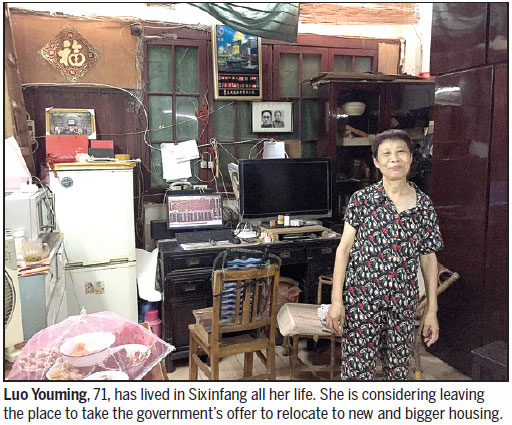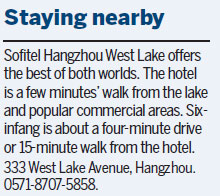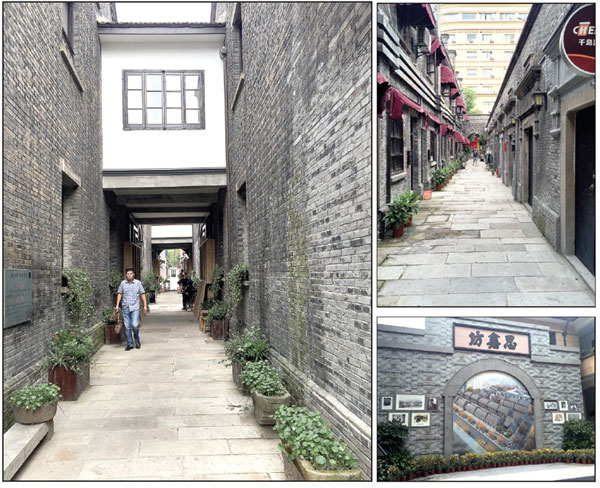Something old, something new
Updated: 2016-09-26 08:06
By Yang Feiyue(China Daily)
|
||||||||
An ancient neighborhood in Hangzhou strives to balance tradition and modernity. Yang Feiyue reports.
It is a distinctive cluster of low-slung historical buildings, tucked away from the hustle and bustle of the West Lake area in Hangzhou, Zhejiang's provincial capital.
Minutes ago, I was wandering around the commercial hot spots nearby, where skyscrapers wearing Starbucks, Gap and Apple logos hug the streets. Now, two-story structures of black bricks with dark wooden doors framed in stone have sprung up before me.
It's quiet.
|
Colockwise from left: The Sixinfang community in Hangzhou hosts centuries-old black-brick structures. A restoration project last year has helped the neighborhood retain its historical and cultural glamor. Photos by Yang Feiyue / China Daily |

These centuries-old buildings stretch neatly in all directions of the Sixinfang community in Shangcheng district.
Lou Youming is preparing lunch in a tiny, shabby kitchen right at the entrance of one building as I explore the network of lanes. She steps out from the kitchen when I say hello.
The 71-year-old looks hale and hearty. Lou has lived here all her life.
She invites me in and points to a wooden ladder on the right as we pass the kitchen.
"Other households take the ladder to get upstairs," she says.
Her place was right on the ground floor - a long, dim, narrow lane leads to a roughly 20-square-meter room where she now lives with her husband. A fridge, a TV and a few pieces of old-fashioned furniture are crammed into the room.
Three households are living in the building, and they share the same door.
The old couple enjoys their daily routine. They go to the lake twice a day. It's a five-minute walk away.
"We'll normally get up at 5 in the morning and walk around the lake for two hours," Lou says, smiling.
They'll do it again late in the day.
Sixinfang hosts roughly 220 households, and many residents, like Lou, have lived there for a long time.
The site was a ministry garrison during the Qing Dynasty (1644-1911), before it was purchased by Chen Xingong, a rich merchant, in the 1920s.
Chen remodeled the place after the fashion of Shanghai's shikumen, the stone-framed gatehouses, which integrated some Western elements.
Chen thus became one of the first realtors in Hangzhou.
The whole community covers an area of about 10,000 square meters. In its heyday, it housed the rich and powerful.
Over time, Sixinfang's inhabitants changed from the rich to ordinary residents.
Things took a downturn after the 1980s.
"The planned economy shifted toward a market economy, and high buildings began to emerge all around," says Lou.
"People working in those buildings needed to have lunch, so many small restaurants opened."
That was the start of a problem. Most of those catering businesses were illegal and poorly equipped, producing sewage flows as well as a suffocating cooking smoke that shrouded the whole neighborhood.
"We closed our windows and doors and didn't dare to come out," Lou recalls.
She used to get up early to hang out her washed clothes, then take them inside before noon when those restaurants started cooking, and hang them out again after the lunch rush.
Over time, the buildings developed leaky roofs, blocked sewage systems and termites after weathering long years.
Things only began to look up early last year. The local authority set up monitoring outposts in the community to ensure those restaurants won't pop up again.
"The problem was persistent because restaurant owners would reopen their business once we left," says Wang Weishi, a publicity officer with Sixinfang.
The authority has also restored the neighborhood, rewired the electrical network and built sanitary restrooms, Wang adds.

Exterior improvements are basically finished, and interior work on the buildings will begin later this year.
The idea is to restore Sixinfang's charm and weave it back into Hangzhou's historical and cultural fabric, Wang explains.
Wang says help from cultural experts may be needed.
Now, a bookstore exhibiting works by prominent locals has opened, along with a free museum.
Lou says that the government may offer residents two choices soon: continue to live there and have their homes' interiors upgraded or take a government offer to relocate.
"I'm considering taking the new place, since it would be new and bigger," Lou says.
The downside for her is that the new housing is a bit farther away from her beloved West Lake.
"It's so beautiful and all natural, with blue skies and white clouds," she says.
"I'll visit it more now, since I might not be able to see it every day in the future."
Contact the writer at yangfeiyue@chinadaily.com.cn
(China Daily 09/26/2016 page22)
- Car-crazy Mexico City celebrates World Carfree Day
- Death toll rises to 52 after migrant boat capsizes off Egypt
- China and US should move forward regardless of election result
- Threat of 'lone wolf' terrorism rises: Aussie PM
- DPRK warns of retaliation against US, ROK
- US fighter jet crashes off coast of Okinawa, Japan: DM

 Li, Trudeau inaugurate 'new annual dialogue'
Li, Trudeau inaugurate 'new annual dialogue'
 Milan Fashion Week: Prada Spring/Summer 2017
Milan Fashion Week: Prada Spring/Summer 2017
 Panchen Lama prayers at foot of Qomolangma
Panchen Lama prayers at foot of Qomolangma
 Ai Fukuhara and her newlywed husband show up in Taiwan
Ai Fukuhara and her newlywed husband show up in Taiwan
 8 things you may not know about Autumn Equinox
8 things you may not know about Autumn Equinox
 Italian sets new record with Ferrari on 'miracle road'
Italian sets new record with Ferrari on 'miracle road'
 Students compete for flight attendant jobs in Sichuan
Students compete for flight attendant jobs in Sichuan
 1st Sushi restaurant opens in DPRK
1st Sushi restaurant opens in DPRK
Most Viewed
Editor's Picks

|

|

|

|

|

|
Today's Top News
Trump outlines anti-terror plan, proposing extreme vetting for immigrants
Phelps puts spotlight on cupping
US launches airstrikes against IS targets in Libya's Sirte
Ministry slams US-Korean THAAD deployment
Two police officers shot at protest in Dallas
Abe's blame game reveals his policies failing to get results
Ending wildlife trafficking must be policy priority in Asia
Effects of supply-side reform take time to be seen
US Weekly

|

|








